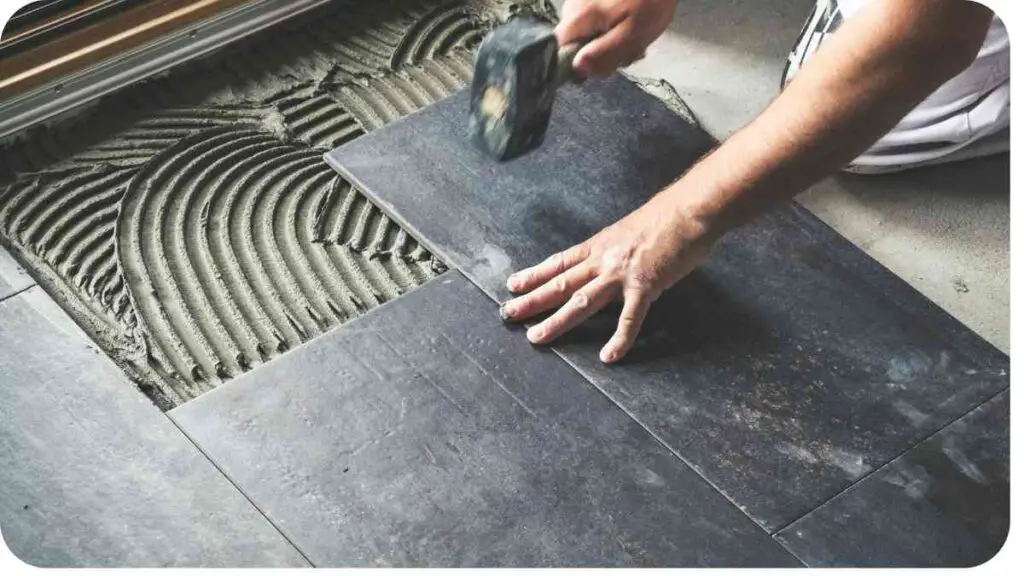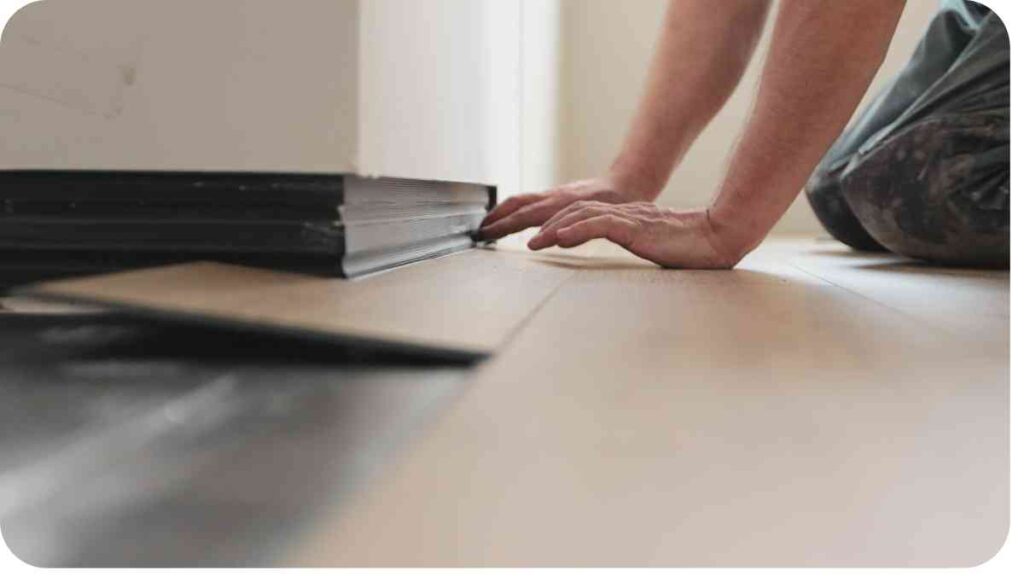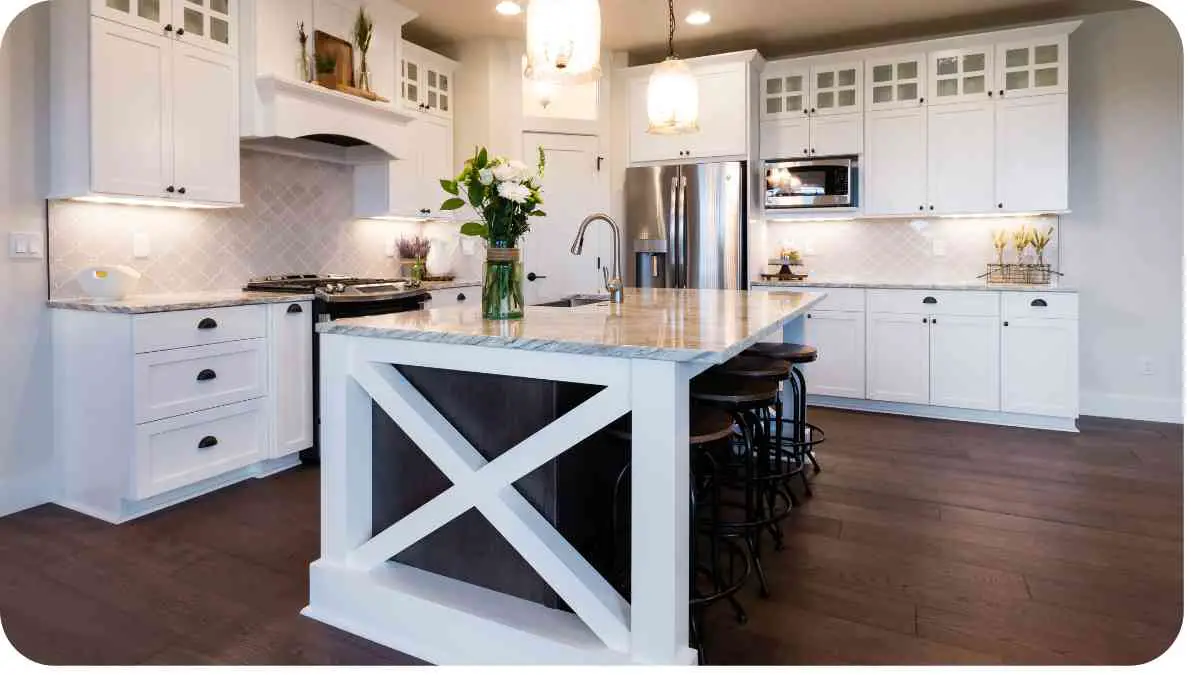Finding the perfect flooring for your kitchen can be a daunting task, especially when you’re on a budget. However, with the right knowledge and guidance, you can achieve style and functionality without breaking the bank. In this article, we’ll explore various inexpensive kitchen flooring ideas that will add flair to your space without compromising on quality.
| Takeaways |
|---|
| 1. You can achieve stylish kitchen flooring without overspending by opting for cost-effective options like laminate, vinyl, linoleum, ceramic tile, cork, or bamboo. |
| 2. Consider factors such as durability, water resistance, style, installation ease, maintenance requirements, and budget constraints when choosing the right flooring material for your kitchen. |
| 3. DIY installation may be feasible for some flooring types, but professional installation may be necessary for more complex materials like ceramic tile or cork. |
| 4. Regular maintenance, including sweeping, mopping, and occasional resealing, will help prolong the life and appearance of your kitchen flooring. |
| 5. Explore eco-friendly options such as linoleum or bamboo flooring for sustainability benefits while staying within your budget. |
Benefits of Inexpensive Kitchen Flooring
Investing in inexpensive kitchen flooring offers several advantages. Firstly, it allows you to allocate your budget to other essential aspects of kitchen remodeling, such as appliances or countertops. Additionally, many affordable flooring options are durable and easy to maintain, making them ideal for high-traffic areas like the kitchen.
Revamp your bathroom without breaking the bank with these Affordable Bathroom Flooring Ideas that combine style and savings. Transform your space affordably!
By opting for cost-effective solutions, you can achieve the look you desire without overspending.
Table 1: Benefits of Inexpensive Kitchen Flooring
| Benefits |
|---|
| Cost-effective |
| Durable and long-lasting |
| Easy to maintain and clean |
| Wide variety of styles and designs |
Factors to Consider Before Choosing Flooring
Before selecting kitchen flooring, there are several factors to consider to ensure you make the right choice for your home.
- Durability: Kitchen floors endure heavy foot traffic, spills, and dropped items. Opt for materials that can withstand these challenges without showing signs of wear and tear.
- Water Resistance: Kitchens are prone to spills and moisture. Choose flooring options that are water-resistant or waterproof to prevent damage and mold growth.
- Style and Design: Your flooring should complement the overall aesthetic of your kitchen. Consider the color, texture, and pattern that will best suit your space.
- Ease of Installation: If you’re considering DIY installation, select flooring materials that are relatively easy to install. However, complex installations may require professional assistance.
- Maintenance Requirements: Some flooring types require more upkeep than others. Assess your willingness to perform regular maintenance tasks such as sweeping, mopping, and sealing.
- Budget: Determine your budget constraints and explore cost-effective flooring options that align with your financial resources.
Table 2: Factors to Consider Before Choosing Flooring
| Factors | Considerations |
|---|---|
| Durability | Heavy foot traffic, durability against spills and drops |
| Water Resistance | Ability to withstand moisture and spills |
| Style and Design | Complementing kitchen aesthetic, color, texture, pattern |
| Ease of Installation | DIY vs. professional installation, complexity |
| Maintenance Requirements | Regular upkeep, cleaning, and sealing |
| Budget | Financial constraints, cost-effective options |
Considering these factors will help you narrow down your choices and select the best flooring option for your kitchen.
Types of Inexpensive Kitchen Flooring

When it comes to inexpensive kitchen flooring, several options offer affordability without sacrificing style or quality. Let’s explore some popular choices:
Planning a deck project? Dive into our comprehensive 10×12 Deck Material List for expert advice and essential insights on materials, costs, and more.
Laminate Flooring
Laminate flooring is a cost-effective alternative to hardwood and tile. It consists of multiple layers, including a durable wear layer, a decorative layer that mimics the look of wood or tile, and a core layer for stability. Laminate is easy to install, often featuring a click-lock system that allows for DIY installation. Additionally, it’s resistant to scratches, stains, and fading, making it ideal for kitchens.
Table 3: Laminate Flooring Overview
| Features | Details |
|---|---|
| Material | Multiple layers including wear, decorative, and core |
| Installation | DIY-friendly click-lock system |
| Durability | Resistant to scratches, stains, and fading |
| Maintenance | Easy to clean with regular sweeping and mopping |
| Cost | Affordable compared to hardwood and tile |
Vinyl Flooring
Vinyl flooring is another budget-friendly option for kitchens. Available in sheet, tile, or plank forms, vinyl offers versatility in design and installation. It’s highly resilient, withstanding water, stains, and scratches. Additionally, vinyl is comfortable underfoot and provides excellent sound absorption. With its wide range of styles, including wood and stone looks, vinyl allows you to achieve the desired aesthetic without exceeding your budget.
Discover alternatives to traditional deck materials in our in-depth guide on Exploring Deck Material Alternatives. Find the perfect fit for your project!
Table 4: Vinyl Flooring Overview
| Features | Details |
|---|---|
| Types | Sheet, tile, or plank |
| Versatility | Various designs including wood and stone looks |
| Resilience | Water, stain, and scratch-resistant |
| Comfort | Comfortable underfoot, provides sound absorption |
| Affordability | Cost-effective compared to other flooring options |
Linoleum Flooring
Linoleum flooring is a natural and eco-friendly option that has regained popularity in recent years. Made from linseed oil, cork dust, wood flour, and other renewable materials, linoleum is durable, long-lasting, and biodegradable. It comes in a variety of colors and patterns, allowing for creative design possibilities in the kitchen. Linoleum is also resistant to water and stains, making it a practical choice for busy households.
Table 5: Linoleum Flooring Overview
| Features | Details |
|---|---|
| Material | Made from natural and renewable ingredients |
| Durability | Durable and long-lasting |
| Design Options | Wide range of colors and patterns available |
| Water Resistance | Resistant to water and stains |
| Eco-Friendly | Biodegradable and environmentally sustainable |
Ceramic Tile Flooring
Ceramic tile flooring is a classic choice for kitchens due to its durability and versatility. Available in various shapes, sizes, colors, and patterns, ceramic tiles allow for endless design possibilities. They are resistant to water, stains, and heat, making them ideal for kitchen use. While ceramic tile installation may require professional expertise, the long-term durability and aesthetic appeal make it a worthwhile investment.
Not sure which deck material is right for you? Compare options with our detailed guide on Comparing Deck Materials. Make an informed decision for your outdoor space!
Table 6: Ceramic Tile Flooring Overview
| Features | Details |
|---|---|
| Versatility | Various shapes, sizes, colors, and patterns |
| Durability | Resistant to water, stains, and heat |
| Installation | Professional installation may be required |
| Maintenance | Easy to clean with regular maintenance |
| Longevity | Durable and long-lasting |
Cork Flooring
Cork flooring offers a unique blend of style, comfort, and sustainability. Harvested from the bark of cork oak trees, cork flooring is eco-friendly and renewable. It provides a cushioned feel underfoot, making it comfortable to stand on for extended periods, which is beneficial for kitchen tasks.
Cork is naturally resistant to mold, mildew, and pests, making it an excellent choice for kitchens where moisture is present. Additionally, cork’s natural insulating properties help to keep your kitchen warm in the winter and cool in the summer.
Table 7: Cork Flooring Overview
| Features | Details |
|---|---|
| Material | Harvested from cork oak trees |
| Comfort | Cushioned feel underfoot, comfortable for standing |
| Sustainability | Eco-friendly and renewable |
| Resistance | Naturally resistant to mold, mildew, and pests |
| Insulation | Natural insulating properties for temperature control |
Bamboo Flooring
Bamboo flooring is a sustainable and cost-effective option for kitchen flooring. As one of the fastest-growing plants, bamboo is renewable and environmentally friendly. Bamboo flooring comes in various styles, including natural, carbonized, and strand-woven, providing versatility in design. It is durable, with a hardness comparable to hardwood, and resistant to moisture and stains. Bamboo flooring is easy to maintain and can add warmth and elegance to your kitchen space.
Table 8: Bamboo Flooring Overview
| Features | Details |
|---|---|
| Sustainability | Fast-growing and renewable |
| Styles | Natural, carbonized, and strand-woven options |
| Durability | Comparable hardness to hardwood |
| Resistance | Moisture and stain-resistant |
| Maintenance | Easy to clean and maintain |
Exploring these inexpensive kitchen flooring options will help you find the perfect balance between style, functionality, and budget for your kitchen renovation project.
Comparison of Different Flooring Types

To make an informed decision about your kitchen flooring, it’s essential to compare the various options available. Let’s compare laminate, vinyl, linoleum, ceramic tile, cork, and bamboo flooring based on key factors:
Get creative with your outdoor space using our step-by-step tutorial on DIY Concrete Stones. Transform plastic bags into beautiful, durable accents for your garden or patio!
Durability
- Laminate: Resistant to scratches and fading, but may be susceptible to moisture damage if not properly sealed.
- Vinyl: Highly resilient against scratches, stains, and water damage, making it suitable for kitchens.
- Linoleum: Durable and long-lasting, resistant to water and stains, ideal for high-traffic areas.
- Ceramic Tile: Extremely durable and resistant to water, stains, and heat, suitable for heavy-duty use in kitchens.
- Cork: While resilient, may dent or scratch more easily than other materials if not properly maintained.
- Bamboo: Comparable hardness to hardwood, making it durable and suitable for kitchens.
Table 9: Durability Comparison
| Flooring Type | Durability |
|---|---|
| Laminate | Resistant to scratches and fading, susceptible to moisture damage |
| Vinyl | Highly resilient against scratches, stains, and water damage |
| Linoleum | Durable and long-lasting, resistant to water and stains |
| Ceramic Tile | Extremely durable, resistant to water, stains, and heat |
| Cork | Resilient, may dent or scratch more easily |
| Bamboo | Comparable hardness to hardwood, durable |
Installation
- Laminate: DIY-friendly click-lock system allows for easy installation.
- Vinyl: Can be installed as sheets, tiles, or planks, with options for DIY or professional installation.
- Linoleum: DIY installation possible, but may require adhesive and specialized tools for optimal results.
- Ceramic Tile: Typically requires professional installation due to the complexity of laying tiles and grouting.
- Cork: Installation may vary depending on the type of cork flooring chosen, may require professional assistance.
- Bamboo: Can be installed as tongue-and-groove planks, may require professional installation for optimal results.
Table 10: Installation Comparison
| Flooring Type | Installation |
|---|---|
| Laminate | DIY-friendly click-lock system |
| Vinyl | Options for DIY or professional installation |
| Linoleum | DIY installation possible, may require adhesive and specialized tools |
| Ceramic Tile | Typically requires professional installation |
| Cork | Installation may vary, may require professional assistance |
| Bamboo | Can be DIY-installed, but professional installation may be preferable |
Maintenance and Cleaning
- Laminate: Easy to clean with regular sweeping and mopping. Avoid using excessive water to prevent damage.
- Vinyl: Low maintenance, requiring only regular sweeping and occasional mopping with a mild detergent.
- Linoleum: Simple to maintain, requiring regular sweeping and damp mopping with a pH-neutral cleaner.
- Ceramic Tile: Easy to clean with regular sweeping and mopping, occasional resealing may be necessary to maintain appearance.
- Cork: Requires regular sweeping and damp mopping with a mild detergent. Periodic resealing may be needed to protect against moisture.
- Bamboo: Easy to clean with regular sweeping and damp mopping. Avoid excessive water to prevent damage.
Table 11: Maintenance and Cleaning Comparison
| Flooring Type | Maintenance and Cleaning |
|---|---|
| Laminate | Easy to clean with regular sweeping and mopping |
| Vinyl | Low maintenance, occasional mopping with mild detergent |
| Linoleum | Simple maintenance, regular sweeping and damp mopping |
| Ceramic Tile | Easy to clean, occasional resealing may be necessary |
| Cork | Requires regular sweeping and damp mopping |
| Bamboo | Easy to clean with regular sweeping and damp mopping |
Cost
- Laminate: Generally affordable compared to hardwood and tile flooring options.
- Vinyl: Cost-effective option with a wide range of price points to fit various budgets.
- Linoleum: Budget-friendly choice with competitive pricing compared to other flooring materials.
- Ceramic Tile: Can range in price depending on the quality and design of the tiles, but generally affordable.
- Cork: Moderately priced, offering a good balance between cost and quality.
- Bamboo: Generally affordable, especially considering its durability and sustainability.
Table 12: Cost Comparison
| Flooring Type | Cost |
|---|---|
| Laminate | Generally affordable compared to hardwood and tile |
| Vinyl | Cost-effective with a wide range of price points |
| Linoleum | Budget-friendly choice with competitive pricing |
| Ceramic Tile | Price varies depending on quality and design |
| Cork | Moderately priced, offers good value for money |
| Bamboo | Generally affordable considering durability and sustainability |
Comparing these factors will help you determine the most suitable and cost-effective flooring option for your kitchen renovation project.
DIY vs. Professional Installation
- DIY Installation: Opting for DIY installation can save money on labor costs but requires time, effort, and skill. It’s essential to follow manufacturer instructions carefully and have the necessary tools and expertise to ensure a successful outcome.
- Professional Installation: Hiring professionals guarantees expert craftsmanship and ensures that the flooring is installed correctly. While it may incur additional expenses, professional installation can save time and provide peace of mind, especially for complex flooring materials like ceramic tile or cork.
Table 13: DIY vs. Professional Installation
| Installation Type | Considerations |
|---|---|
| DIY | Cost-effective, requires time, effort, and skill |
| Professional | Expert craftsmanship, ensures correct installation |
Deciding between DIY and professional installation depends on your budget, timeline, and level of expertise. Consider your capabilities and preferences before making a decision.
Testimonials from Homeowners
Here are some testimonials from homeowners who have installed inexpensive kitchen flooring:
- Sarah: “We chose vinyl flooring for our kitchen, and we couldn’t be happier! It looks just like hardwood but at a fraction of the cost. Installation was a breeze, and it’s so easy to clean. Highly recommend it!”
- Michael: “Linoleum flooring was the perfect choice for our busy kitchen. It’s held up remarkably well against spills and scratches, and the price was unbeatable. Plus, it’s eco-friendly, which was important to us.”
- Emily: “We opted for ceramic tile flooring, and it’s been a game-changer. It looks stunning, and we love the variety of designs available. While the installation was a bit pricey, the long-term durability makes it worth every penny.”
These testimonials highlight the diverse experiences and satisfaction levels of homeowners with different types of inexpensive kitchen flooring.
Conclusion
Selecting the right kitchen flooring can significantly impact the overall look, feel, and functionality of your space. Despite being on a budget, you don’t have to compromise on style or quality. Inexpensive kitchen flooring options such as laminate, vinyl, linoleum, ceramic tile, cork, and bamboo offer a wide range of benefits without breaking the bank.
By considering factors such as durability, installation, maintenance, and cost, you can make an informed decision that suits your needs and preferences. Whether you prefer the affordability and versatility of laminate or the eco-friendliness of cork, there’s a flooring option to match your style and budget.
Remember to weigh the pros and cons of DIY versus professional installation and gather testimonials from homeowners who have firsthand experience with the flooring materials you’re considering. Their insights can provide valuable guidance and help you make the right choice for your kitchen renovation project.
In conclusion, with careful planning and research, you can achieve style and functionality on a budget with inexpensive kitchen flooring options. Transform your kitchen into a space you’ll love to cook and entertain in without breaking the bank.
If you have any further questions or need assistance with your kitchen flooring project, don’t hesitate to reach out to flooring experts or home improvement professionals for personalized advice and recommendations.
Further Reading
- Better Homes & Gardens: Affordable Kitchen Flooring Ideas: Explore budget-friendly flooring options for your kitchen renovation project.
- The Spruce: Inexpensive Kitchen Flooring Ideas: Discover creative and affordable flooring solutions to enhance your kitchen’s aesthetic.
- Angi: Cheap Kitchen Floor Ideas: Get inspired by cost-effective flooring ideas to transform your kitchen on a budget.
FAQs
What are some affordable kitchen flooring options?
You can consider laminate, vinyl, linoleum, ceramic tile, cork, and bamboo flooring as cost-effective options for your kitchen.
Is DIY installation recommended for kitchen flooring?
DIY installation can be suitable for certain flooring types like laminate or vinyl, but for materials like ceramic tile or cork, professional installation may ensure better results.
How do I maintain and clean inexpensive kitchen flooring?
Regular sweeping and damp mopping with a mild detergent are typically sufficient for maintaining most inexpensive kitchen flooring options. Be sure to follow manufacturer recommendations for specific care instructions.
Can inexpensive kitchen flooring be durable?
Yes, many affordable flooring options like vinyl and ceramic tile are highly durable and can withstand the rigors of daily kitchen use, providing long-lasting performance.
Are there eco-friendly options available for inexpensive kitchen flooring?
Yes, materials like linoleum and bamboo are eco-friendly and sustainable choices for kitchen flooring, offering both affordability and environmental benefits.

I am Hellen James, a professional handywoman with expertise in improving home and garden spaces by using pergolas, gazebos, and tents.


